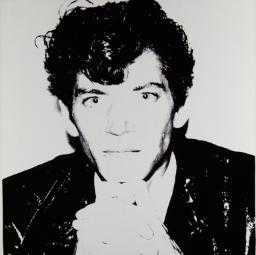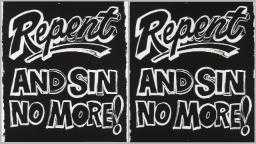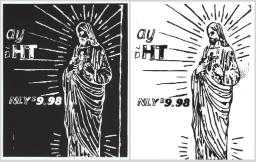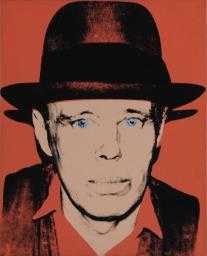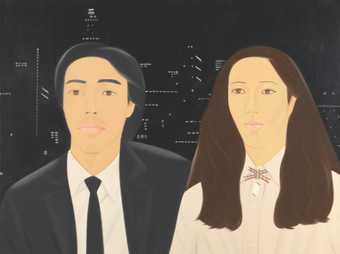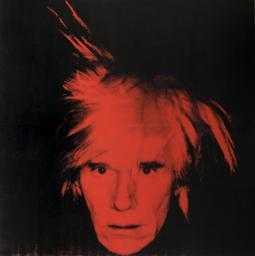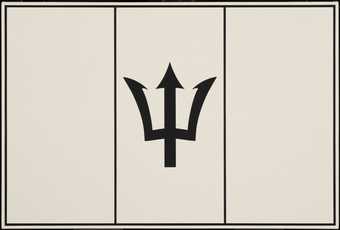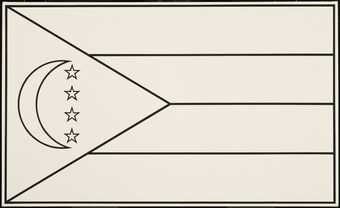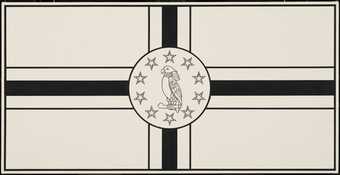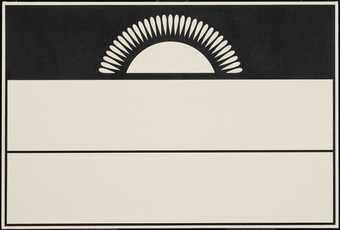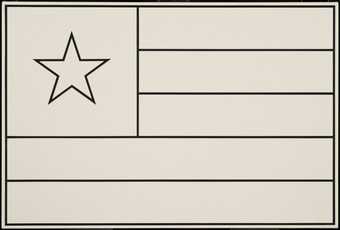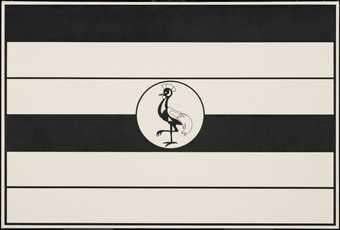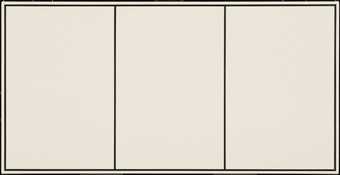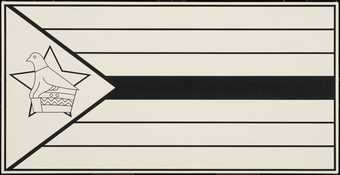
Not on display
- Artist
- Peter Halley born 1953
- Medium
- Acrylic paint on canvas
- Dimensions
- Support: 2490 × 4825 × 95 mm
- Collection
- Tate
- Acquisition
- Presented by the Mottahedan Family 2014
- Reference
- T14480
Summary
Rob and Jack is a painting in acrylic on canvas produced in the artist’s studio in New York in 1990. Large-scale and rectangular in format, it depicts an abstract composition of geometric lines and shapes divided at the centre into two symmetrical halves, against a background of bright, flat colour. A square sits at the centre of each section – red against a yellow, orange and red background on the left, black against a blue, red and brown background on the right – around which vertical and horizontal bars akin to conductive tracts on a circuit board divide up the space. The work was produced using acrylic paint, fluorescent Day-Glo acrylic paint and Roll-a-Tex, a textured paint used for interior decoration. Halley has employed a stark geometric vocabulary since the 1980s, varying only the configurations and colour combinations with each subsequent painting.
Following his return to New York from New Orleans in 1980 Halley became a leading practitioner among a group of artists working in the East Village, including Philip Taaffe, Sherrie Levine and Ashley Bickerton. Termed neo-geo (or neo-geometric conceptualism) for its use of geometric forms, the work of this loosely affiliated group emerged from that of the Pictures Generation. Their work also referenced minimalist, pop and conceptual practices, which had animated the New York art world since the 1960s, but in a mode more critical of the mechanisation and commercialisation of the modern world. As a result, Halley’s practice – like that of many of his contemporaries – became deeply theoretical in character. Influenced in particular by post-structuralist theory and the writings of French sociologist, philosopher and cultural theorist Jean Baudrillard, Halley’s paintings, substantiated by the artist’s writings, conceal an acute awareness of the links between art, commodity culture and politics, and challenge what he deemed to be minimalism’s falsely transcendental claims.
While Halley’s geometric language may appear abstract, the artist sees it as a system of motifs to imagine the spatial arrangement of society. In his succinct seven-point essay, ‘Notes on the Paintings’ of 1982, he explained:
1. These are paintings of prisons, cells and walls.
2. Here, the idealist square becomes the prison. Geometry is revealed as confinement.
3. The cell is a reminder of the apartment house, the hospital bed, the school desk the isolated endpoints of industrial structure.
4. The paintings are a critique of idealist modernism. In the ‘color field’ is placed a jail. The misty space of Rothko is walled up.
5. Underground conduits connect the units. ‘Vital fluids’ flow in and out.
6. The ‘stucco’ texture is a reminiscence of motel ceilings.
7. The Day-Glo paint is a signifier of ‘low budget mysticism’. It is the afterglow of radiation.
(Halley 1988, p.23.)
These comments could relate as much to Rob and Jack as they do to earlier paintings from the 1980s. Using elements from circuit boards, psychological flowchart diagrams and computer science textbooks as visual resources, Halley developed a vocabulary of isolated squares and linked lines which are arranged in different configurations to indicate the social networks that connect individuals in the contemporary urban environment. Representations of both isolation and connectivity, his works address the way in which communication and interaction occurs through pre-determined spatial networks, information flows (or ‘conduits’), such as transportation systems and electrical grids, that link people in increasingly geometric social spaces. Halley continued:
When I first came to New York, I felt the isolation of living in an apartment – it was a singular, individual existence … Afterwards, there was a transformation in my point of view … I realised that I wasn’t so isolated, that I was tied in with others – not through an experience of shared public space, but rather through all kinds of media – such as the telephone or television, and later the internet. The spaces of my work became premised on the idea that the way we live is characterised by physical isolation, but that we are reconnected through technology. Technology and economics create these channels of communication in ways that we do not choose. I pictured this by painting bands that I call ‘conduits’ that connect the prisons and cells.
(Quoted in Lodermeyer, de Jongh and Gold 2009, p.276.)
Made luminous by the use of fluorescent Day-Glo paint that visualises the flow of electricity through a network of cables, Rob and Jack might be seen as a visual representation of communication. Rather than interact with each other, the two beings of the painting’s title are isolated, represented side by side by the two separately coloured ‘cells’. Although the two sections of the painting remain disconnected, the conduits extending from and intersecting them suggest another means of connection to the mass of information channels in the technological maze of the modern urban environment beyond.
Further reading
Peter Halley, Collected Essays 1981–87, Zurich and New York 1988.
Peter Halley, exhibition catalogue, Museo Nacional Centro de Arte Reina Sofía, Madrid 1992.
Peter Lodermeyer, Karlyn de Jongh and Sarah Gold, Personal Structures: Time, Space, Existence, Cologne 2009, pp.27681.
Hannah Johnston
November 2014
Does this text contain inaccurate information or language that you feel we should improve or change? We would like to hear from you.
You might like
-
Andy Warhol Robert Mapplethorpe
1983 -
Andy Warhol Repent and Sin No More!
1985–6 -
Andy Warhol Christ $9.98 (negative and positive)
1985–6 -
Andy Warhol Portrait of Joseph Beuys
1980 -
Alex Katz Hiroshi and Marcia
1981 -
Andy Warhol Self-Portrait
1986 -
Fred Wilson Antigua-Barbuda
2009 -
Fred Wilson Barbados
2009 -
Fred Wilson Comoros
2009 -
Fred Wilson Dominica
2009 -
Fred Wilson Malawi
2009 -
Fred Wilson Togo
2009 -
Fred Wilson Uganda
2009 -
Fred Wilson Nigeria
2009 -
Fred Wilson Zimbabwe
2009

